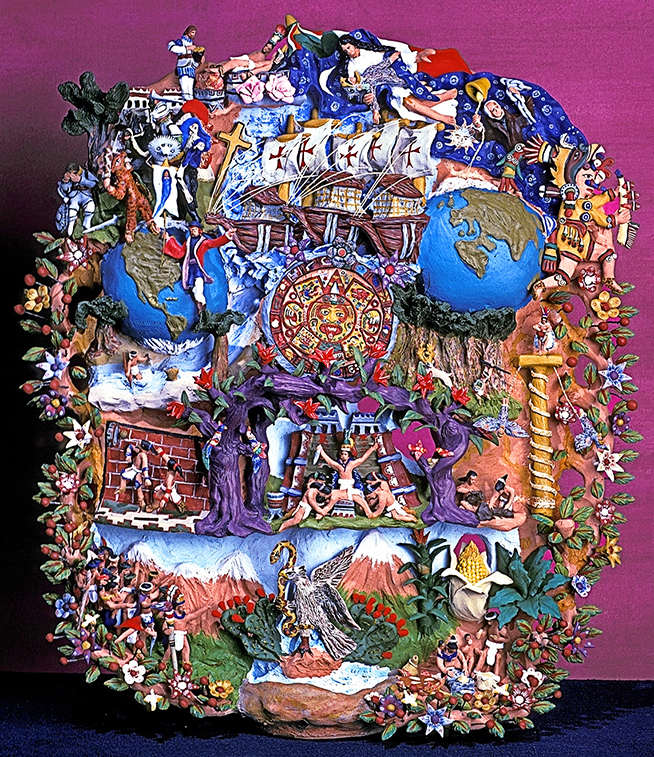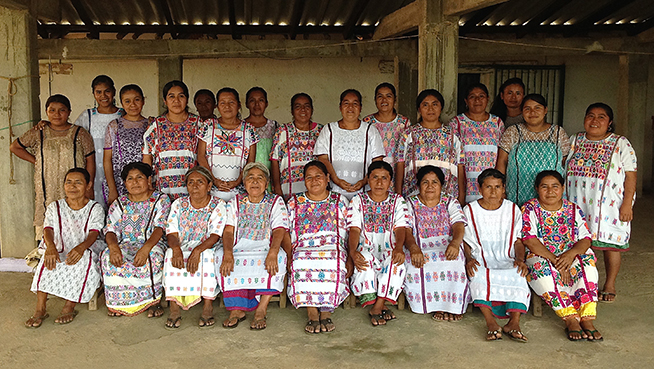Modern Mexico: Fusions, Fashion and Folk Art

By Ana Galindo
Since the opening of the ¡Viva México! exhibition at the ROM in May 2015, we have been generously treated to a myriad of events related to the show—visiting artists, talks and Friday Night Live events. Most recently, the museum hosted a magnificent symposium introducing attendees to the ideas and work of various academics and experts on the visual culture of Mexico.
The conference had a most auspicious start when Chloë Sayer, guest curator of the show, was presented with the Ohtli Award (Reconocimiento Ohtli) conferred by the Institute of Mexicans Abroad, an agency of the Mexican Ministry of Foreign Affairs, and presented by the Consul General of Mexico in Toronto, Ambassador Mauricio Toussaint.
The Ohtli Award is the highest honour bestowed on a member of the Mexican, Mexican-North American and Hispanic communities, and is “given to people who have dedicated most of their life and professional activity to ‘open the path abroad’”, recognizing the impressive contribution Chloë has made to Mexican culture. Her distinguished career has been spent on studying, understanding and supporting Mexican artisans. She has rightly identified them as contemporary artists, shedding light on their art and traditions, both inside and outside Mexican territory. Inevitably, it is impossible not to think of her as the Irmgard Weitlaner Johnson of our time.
Chloë Sayer and Dr. Alexandra Palmer, Senior Curator of Textiles & Costume at the ROM, put together a panel of experts, each of whom shared very distinct outlooks on the subject of arts and crafts in Mexico. In speaking with other attendees during the event, we all concluded that due to the level and trajectory of the lecturers, this is the kind of conference you travel to attend—like the TEXTIM conference in Oaxaca, organized biennially by the Textile Museum of Oaxaca, Mexico.
Chloë started the colloquium by delving into the concept of the intangible cultural heritage in Mexico and its resulting objects, which inevitably, are the product of the fusion of cultures, that is, the consequence of the tumultuous and rich history Mexico bears. From Metepec to San Pablito, these notions helped introduce each of the topics the speakers would present. Among these topics, she talked about the Linares family, creators of the original alebrijes, who work mainly with papier mâché to create pieces for ceremonies such as the Burning Judas during Easter; master ceramists such as Tiburcio Soteno and his Trees of Life; the cosmic significance of the Voladores de Papantla and most certainly the unique Huaquechula Altars for the celebrations of the Day of the Dead.

Humberto Spíndola, contemporary Mexican artist, took us on a road to the Mexican baroque and the use of paper in Mexican art throughout the ages, elaborating on how all this informs his own installation work using paper. His insight on how the history of Mexican art influences the contemporary was fascinating and made the past relevant for the present.
Rick López, professor at Amherst College and author of Crafting Mexico: Intellectuals, Artisans, and the State after the Revolution probed further into the authenticity of Mexican folk art, identifying in particular the skillfully made lacquered gourds and wood containers of Olinalá, Guerrero as part of the ever changing cultural heritage, questioning how value is brought to what had not yet been valued before, and how the object may be elevated by re-connecting it to the ancient artisanal traditions.
Senior lecturer at Wellesley College, James Oles, spoke about the phenomenon of “cross-cultural cross-dressing”, the perception of acquiring a different identity when choosing to dress outside our “cast” or ethnicity, in this case represented by the Mexican elites (Alma Reed, Rosa Rolanda—né Rosemonde Cowan, and most certainly Frida), foreigners and mestizas who adopted national or rather traditional dresses as their attire of choice. These pieces of clothing symbolized, in these particular instances, national pride and insurgency against the racist establishment that has forever existed in Mexico.
The last two speakers, anthropologist Marta Turok, and textile designer Ana Paula Fuentes discussed the “here and now” of Mexico. Marta, a folk art specialist and author of numerous books and articles, presented the “debate of cultural rights in ethnic textiles”, basically the appropriation through theft of indigenous clothing patterns and iconography. She clearly explained the case of the traditional Mixe blouse sold through Antik Batik under the name of Isabel Marant, an unapologetic French designer who plagiarized the blouse design and its embroidered motifs. This practice has been too common as big companies or "designer names" profit from blatantly using/stealing/copying the original imagery of indigenous artists, without giving any credit and royalties to them. Importantly Marta also showed the deep historical and culturally loaded symbolism based on ancient traditions is not understood and de-valued by the fashion brands. She was obviously concerned about the lack of cultural and financial recognition and proposed a number of fair practices, including looking closely at the model used by the Kunas in Panama for intellectual property collective rights.
The last lecture by Ana Paula, former Director of the Textile Museum of Oaxaca, brought a note of infinite hope as she shared the awe-inspiring nature of her work. This labour, first in El Camino de los Altos and now at La Flor de Xochistlahuaca, has an elementary tenet, which is to help empower the women in these co-ops to get a better grasp of the work they want to generate in order to create new opportunities for better, dignified living for themselves and their families. The teams are conformed of professional designers and indigenous artists, all working towards injecting “freshness” to the designs yet retaining the traditional imagery and methods of working. More contemporary end-uses are considered while using better-quality materials and incorporating to their already beautifully vibrant palettes, alternative colourways in tandem with trends. In the end, the shared efforts of these amazing women yield attractive, very persuasive products that can be easily brought to market, fetching the deserved profit devoid of any bargaining.
The closing remarks by Alexandra Palmer included the summary of the presentations, which eloquently and succinctly looked back into what the day had delved into connecting traditions old and new and reinforcing the power and significance of contemporary artists to create new meanings that link us to our heritage, comment on the now and pave the way for our future.
It was an unforgettable Saturday, spent amid the cultural reality of Mexico, past, present and future, no passport required.
¡Muchas gracias ROM!
Ana is a volunteer in the Textiles and Fashions Department at the ROM. She is an international multidisciplinary designer/artist/instructor, with many years of experience in the fields of graphic and textile design.
